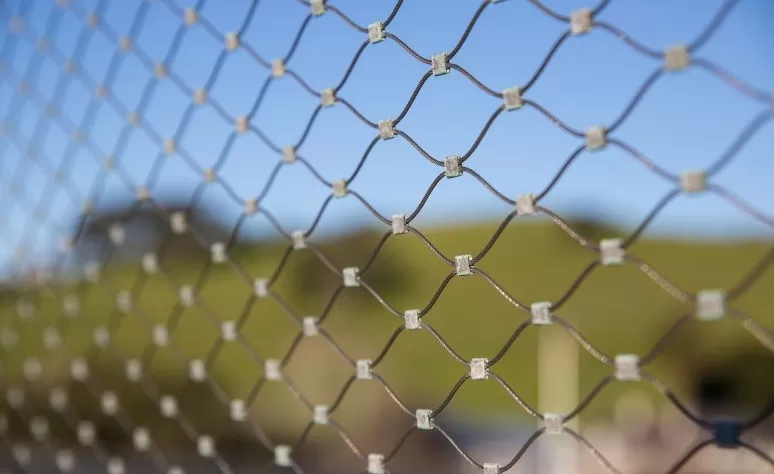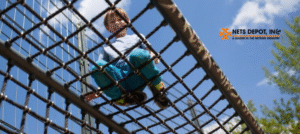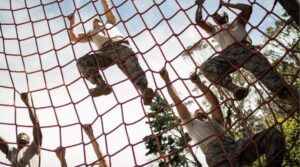Introduction to Barrier Netting
Barrier netting is a versatile and essential tool used across various industries, particularly in sports facilities, construction sites, and environmental protection zones. Its primary function is to create a protective barrier that prevents the passage of debris, balls, or other hazardous materials, ensuring the safety of people and property.
As the demand for more robust and efficient barrier netting grows, manufacturers like Nets Depot Inc are at the forefront of innovation, offering products that meet the stringent safety standards and unique requirements of different applications.
The Evolution of Barrier Netting Technology
The journey of barrier netting from basic, manually woven nets to today’s high-tech solutions is fascinating. Initially, barrier netting was made from natural fibers like cotton or hemp, which were prone to wear and tear. Over time, synthetic materials such as nylon and polyester became the norm, offering greater durability and resistance to environmental factors.
Recent advancements have pushed the boundaries further, introducing new materials and manufacturing techniques that enhance the performance and longevity of barrier netting.
● Innovations in Barrier Netting Materials
➤ High-Density Polyethylene (HDPE)
One of the most significant innovations in barrier netting is the use of High-Density Polyethylene (HDPE). This material is highly resistant to UV rays, chemicals, and extreme weather conditions, making it ideal for outdoor applications. HDPE barrier netting also offers excellent tensile strength, ensuring that the netting can withstand substantial force without breaking.
➤ UV-Resistant Coatings
UV radiation can degrade traditional netting materials, leading to brittleness and reduced effectiveness. To combat this, manufacturers have developed UV-resistant coatings that extend the lifespan of barrier netting. These coatings protect the netting from sun exposure, ensuring that it remains functional for longer periods, even in harsh climates.
➤ Fire-Retardant Materials
Safety is a top priority in many industries, and fire-retardant materials are becoming increasingly popular in barrier netting applications. These materials are designed to prevent the spread of flames, providing an additional layer of protection in environments where fire hazards are a concern.
➤ Recyclable and Eco-Friendly Options
As sustainability becomes a global focus, eco-friendly barrier netting materials are gaining traction. Some manufacturers now offer recyclable netting made from environmentally friendly materials, allowing companies to reduce their carbon footprint while maintaining safety standards.
● Advanced Manufacturing Techniques
➤ Automated Weaving Technology
The introduction of automated weaving technology has revolutionized the production of barrier netting. This technology allows for precise control over the weave pattern, ensuring uniformity and strength across the entire net. Automated weaving also speeds up production, enabling manufacturers to meet large orders with consistent quality.
➤ Seamless Netting
Traditional barrier netting often required stitching or seaming, which could create weak points in the structure. Seamless netting, made possible through advanced manufacturing techniques, eliminates these weak points, resulting in a more robust and durable product.
➤ Customization and Modular Design
Modern barrier netting can be customized to fit specific needs, thanks to modular design techniques. Whether it’s adjusting the size, shape, or color of the netting, manufacturers can now create tailored solutions that meet the unique demands of different applications.
● Smart Barrier Netting: Integration of Technology
➤ Embedded Sensors
One of the most exciting developments in barrier netting is the integration of smart technology. Some barrier netting systems now come with embedded sensors that monitor various parameters, such as tension, weather conditions, and potential breaches. These sensors can send real-time data to a central system, allowing for proactive maintenance and immediate response to any issues.
➤ Remote Monitoring and Control
With the rise of the Internet of Things (IoT), barrier netting can now be remotely monitored and controlled. Facility managers can receive alerts, adjust settings, and even deploy automated responses from anywhere in the world. This level of control enhances the overall safety and efficiency of the netting system.
Read it also:- How Barrier Netting is Revolutionizing Sports Facilities
● Design Improvements for Enhanced Safety
➤ Multi-Layered Netting
To increase the safety and effectiveness of barrier netting, some manufacturers have introduced multi-layered designs. These designs use multiple layers of netting with varying densities to provide superior protection against different types of impact, whether it’s a high-speed baseball or falling debris on a construction site.
➤ Impact-Absorbing Netting
In high-impact environments, the ability of netting to absorb energy and reduce the force of an impact is crucial. Innovations in material science have led to the development of impact-absorbing netting, which dissipates energy more effectively, minimizing the risk of injury or damage.
➤ Enhanced Visibility
For certain applications, such as sports facilities or construction sites, visibility is key. Manufacturers are now producing barrier netting with enhanced visibility features, such as bright colors or reflective strips, making it easier for people to see the netting and avoid accidental contact.
● Applications of Modern Barrier Netting
Barrier netting is used in a wide range of applications, each with its unique set of requirements. Some of the most common uses include:
➤ Sports Facilities
Barrier netting is essential in sports facilities to protect spectators, players, and property from stray balls or other projectiles. The latest innovations in barrier netting technology ensure that these nets are strong, durable, and capable of withstanding the rigors of constant use.
➤ Construction Sites
On construction sites, barrier netting is used to prevent debris from falling and to create safe zones for workers and pedestrians. The use of fire-retardant and impact-absorbing materials in modern barrier netting provides an added layer of protection in these high-risk environments.
➤ Environmental Protection
Barrier netting is also used in environmental protection efforts, such as preventing the spread of invasive species or containing debris in marine environments. The development of eco-friendly netting options aligns with the growing focus on sustainability in environmental conservation.
➤ Industrial Applications
In industrial settings, barrier netting can be used to create safety barriers around machinery or hazardous areas. The integration of smart technology in these nets allows for real-time monitoring and enhances overall safety.
Read this also:- Barrier Netting: Navigating Key Points for Success in 2024
● Comparing Traditional vs. Innovative Barrier Netting
| Feature | Traditional Barrier Netting | Innovative Barrier Netting |
|---|---|---|
| Material | Natural fibers or basic synthetics | HDPE, fire-retardant, eco-friendly |
| Manufacturing | Manual or basic automated | Automated weaving, seamless netting |
| Design | Single-layer, basic visibility | Multi-layered, enhanced visibility |
| Smart Technology Integration | None | Embedded sensors, remote monitoring |
FAQ: Common Questions About Barrier Netting
1. What is barrier netting used for?
Barrier netting is used to create protective barriers in various environments, such as sports facilities, construction sites, and industrial settings.
2. How long does barrier netting last?
The lifespan of barrier netting depends on the materials used and the environmental conditions it is exposed to. Modern barrier netting made from HDPE with UV-resistant coatings can last several years, even in harsh outdoor conditions.
3. Can barrier netting be customized?
Yes, barrier netting can be customized in terms of size, shape, color, and material. Manufacturers can create tailored solutions to meet the specific needs of different applications.
4. Is barrier netting eco-friendly?
Some barrier netting options are made from recyclable and eco-friendly materials, allowing companies to reduce their environmental impact while maintaining safety standards.
Contact Us
At Nets Depot Inc, we specialize in providing state-of-the-art barrier netting solutions for a wide range of applications. Whether you need netting for a sports facility, construction site, or industrial use, our team of experts is here to help you find the perfect solution.
Phone Contact: (305) 215-5579
Email Contact: info@netdepot.com
Get in touch with us today to learn more about our products and how we can help you enhance safety and efficiency with the latest innovations in barrier netting technology.
At Nets Depot Inn, we are committed to providing our clients with the highest quality barrier netting solutions. Our Google My Business profile is a great resource to learn more about our products, read customer reviews, and get updates on our latest innovations. We encourage you to visit our profile, leave a review, and share your experience with others. Your feedback helps us improve and continue delivering top-notch service.






